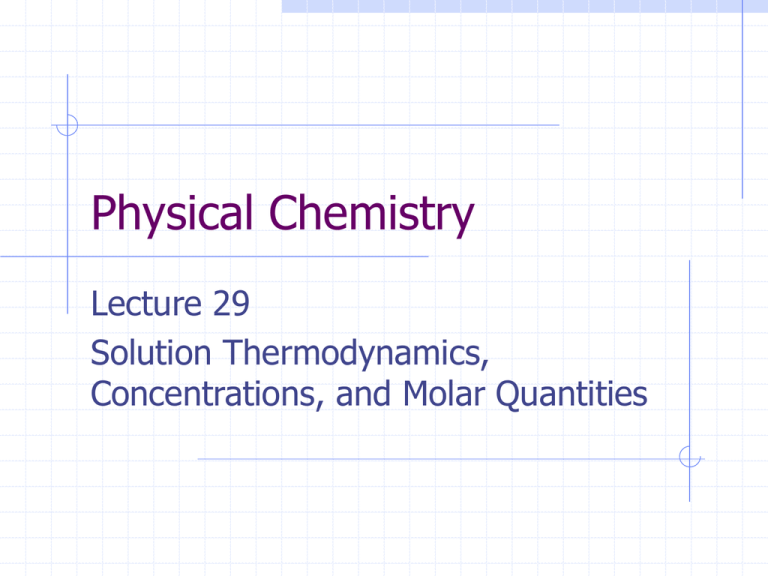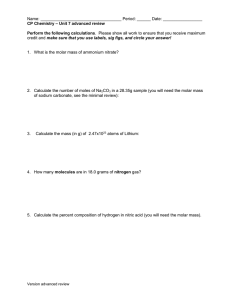Physical Chemistry Lecture 29 Solution Thermodynamics, Concentrations, and Molar Quantities
advertisement

Physical Chemistry Lecture 29 Solution Thermodynamics, Concentrations, and Molar Quantities Components, solutions and mixtures Component A substance added to form a solution or mixture that can be independently varied Solution Material containing multiple components interacting at the molecular level Example: NaCl dissolved in water Physical mixture Material containing multiple components not intermingled at the molecular level Example: NaCl (s) + SiO2 (s) Types of solutions Liquid solutions Usually the kind thought of when the phrase arises Solid solutions Very important kind of solution because many useful materials are solid solutions Example: brass Gas mixtures are always solutions because the interactions are molecule-molecule Thermodynamic properties of solutions Thermodynamic properties depend on two intensive variables and the amount of each material H = H (T , P, n1 , n2 ) Changes in thermodynamic properties depend on three variables dH ∂H dT = T ∂ P ,n1 ,n2 = C P dT ∂H ∂H dP + dn1 + P n ∂ ∂ T ,n1 ,n2 1 T , P , n2 + V dP + H m1 dn1 ∂H dn2 + n ∂ 2 T , P ,n1 + H m 2 dn2 Molar quantities are determined by the way in which thermodynamic quantities change with addition of material Molar quantities are related by the Maxwell relationship ∂H m1 ∂n2 T , P ,n1 ∂H = m 2 ∂n1 T , P ,n2 Relative amounts: concentration descriptions of binary solutions Mole ratio, r Useful when the amount of one component relative to the second affects the property r = n1 n2 Mole fraction, X Useful when the fractional amount of one component determines a property, as in random interactions X2 = n2 n1 + n2 Concentration measures for liquid solutions Solvent: the major component, usually labeled “1” Solute: the minor component, usually labeled “2” Molality, m Number of moles of solute per kilogram of solvent Molarity, c Number of moles of solute per cubic decimeter of solution Relationships of concentration measures All measures of concentration describe the same situation and are related X2 1000 X 2 m = M1 1 − X 2 1 = 1+ r 1000 ρ m c = 1000 + ( M 2 − M 1 + 1) m Mi is the molar mass of substance i, in grams/mole ρ is the density of the solution, in grams/dm3 Partial Molar Quantities Mixing process nA + mB → (n A + m B) Change in a thermodynamic variable such as volume ∆Vmixing = Vsolution − VA• − VB• • = (n AV mA + nB V mB ) − (n AVmA ( • = n A V mA − VmA ) ( • + nB V mB − VmB ) • + nBVmB ) Molar volumes in ethanolwater mixtures Volume of aqueous sodium chloride solutions Volume of Aqueous Sodium Chloride Solutions 1140 1120 3 Volume (cm ) 1100 1080 1060 1040 Lever rule 1020 1000 980 0 0.01 0.02 0.03 0.04 0.05 0.06 0.07 0.08 0.09 0.1 XNaCl Solution volume changes with concentration Lever rule gives the partial molar volumes Determining partial molar volumes from fits Take derivative to find molar volume of solute at each point Find molar volume of solvent at each point by V = nsolvent V solvent + nsolute V solute Can be done in a computer easily y = 0.4577x2 + 18.74x + 1002.6 R2 = 1 3 Volume (cm ) 1150 1100 1050 1000 2 0 4 6 Molality Molar Volumes in Sodium Chloride Solutions 3 V solute ∂V = ∂nsolute nsolvent Volume of Sodium Chloride Solutions Partial Molar Volume (cm ) Using the lever rule can be difficult at times Use the dependence of volume (for a specific amount of solvent) on number of moles of solute to determine the partial molar volume Definition of partial molar volume of the solute 22 21 20 19 18 0 2 4 Molality 6 Summary Solutions more complicated than pure materials Define the state of a solution by relative amount of each component present Several definitions of concentration Choice of unit depends on the situation Thermodynamic quantities depend on concentration Expressed by partial molar quantities Partial molar quantities depend on relative amount of each component Related to differences in interactions at the molecular level



